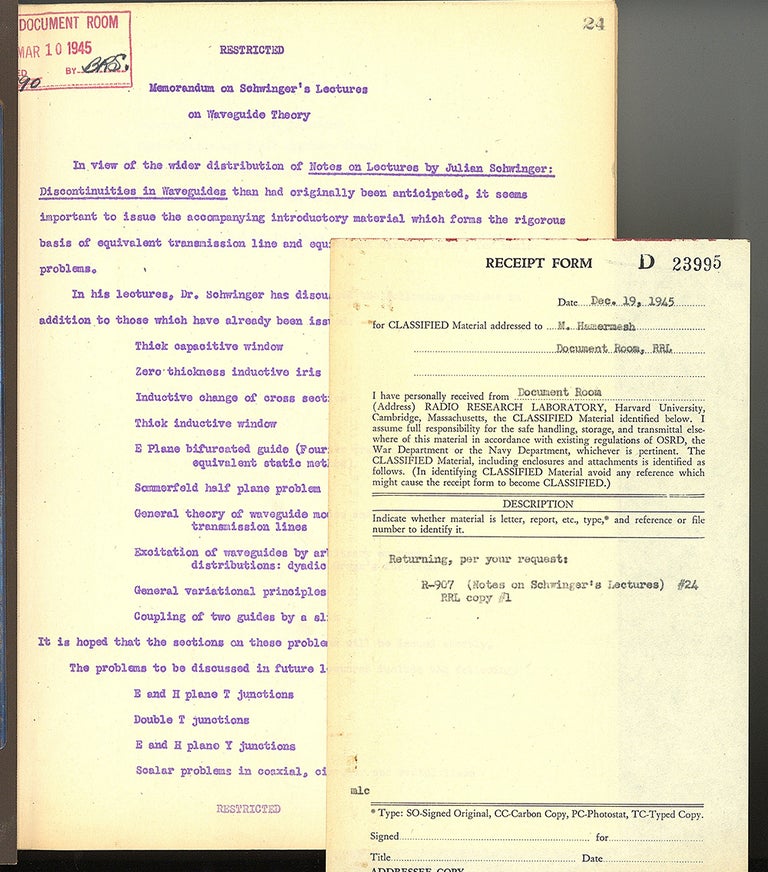
Notes on lectures by Julian Schwinger: Discontinuities in waveguides. Dittoed typescript.
Publisher Information: 1945.
Schwinger, Julian (1918-94). Notes on lectures by Julian Schwinger: Discontinuities in waveguides. Prepared by David S. Saxon. Dittoed typescript, numbered “24”, each leaf stamped “Confidential”; first leaf with Harvard. Radiation Research Laboratory Document Room stamp dated 10 March 1945. [3], xxviii, 109ff. 281 x 217 mm. In stiff binder with metal fasteners, handwritten paper label on the front cover, light wear. Very good. Laid in is a printed “Receipt form” dated 19 December 1945, completed in carbon typescript, showing that this copy had been signed out to Schwinger’s sometime collaborator Morton Hamermesh (1915-2003).
Schwinger was one of the architects of modern quantum electrodynamics, receiving a share of the 1965 Nobel Prize in physics (together with Richard Feynman and Shin’ichiro Tomonaga) for his contribution to QED theory. QED, a synthesis of quantum field theory and special relativity, originated in the 1920s with the work of Heisenberg, Dirac, Pauli and other physicists as a means of describing the behavior of subatomic particles; by the 1940s, however, experimental anomalies and inherent mathematical errors were eroding faith in its validity. Schwinger helped to restore confidence in the theory by developing a method called “mathematical renormalization” to calculate the proper masses and charges of subatomic particles. “[Schwinger’s] efforts culminated in the acceptance of quantum field theory as the proper representation of microscopic phenomena, and he was awarded the Nobel Prize for this achievement” (Schweber, QED and the Men Who Made It, p. 274).
During World War II Schwinger worked on radar and microwave technology at MIT’s Radiation Laboratory, second only to the Manhattan Project in its size and importance to the U. S. war effort. Schwinger was put in charge of the waveguide theory team, responsible for designing the special metallic pipelines needed to conduct microwave energy with minimum loss. “Schwinger felt very comfortable with his assignment, which, because of sheer complexity, was intellectually challenging and matched well his background in electromagnetic interactions in quantum physics. Methodologically, the diffraction of electromagnetic waves resembled the scattering problems in quantum mechanics, so he would not stray too far from conceptually familiar territory . . . The experiences of the Radiation Laboratory turned out to be very stimulating for [Schwinger’s] scientific career and there is no way of knowing what his life as a physicist would look like without them” (Mehra, Climbing the Mountain: The Scientific Biography of Julian Schwinger, p. 106).
The present notes on Schwinger’s Rad Lab waveguide lectures, compiled by his colleague David A. Saxon (1920-2005), were initially marked “Restricted” when they were distributed; this classification was later lowered to “Confidential.” This copy—copy no. 24—was at one time issued to Morton Hamermesh, who would later collaborate with Schwinger on the scattering of slow neutrons by ortho- and para-hydrogen and deuterium.
Book Id: 51017Price: $2,750.00
